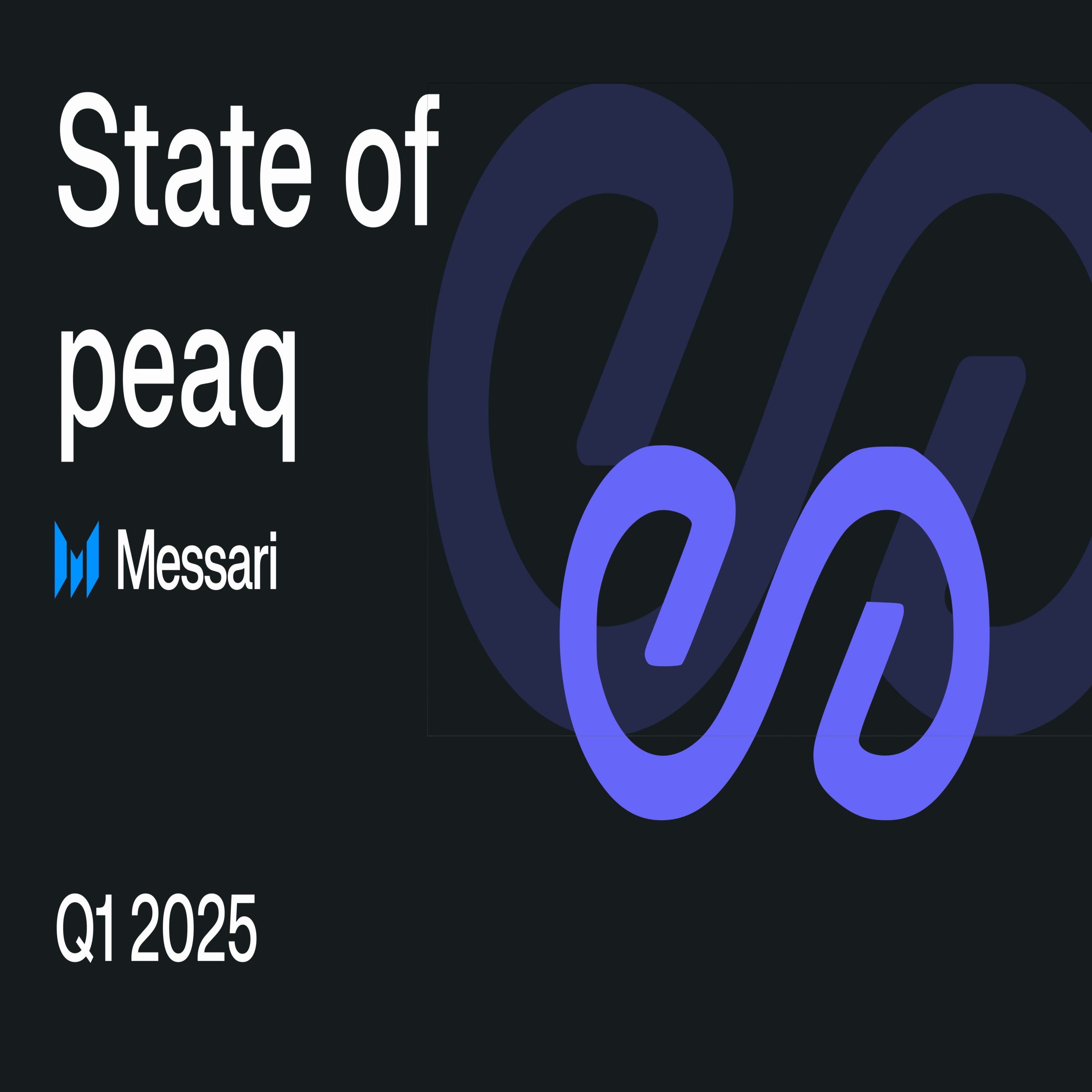Key Insights
- Average daily transactions increased 32.5%, rising from 58,424 in Q4’24 to 77,386 in Q1’25. This growth was supported by the onboarding of new DePINs, machine interactions, and activity driven by the Get Real Campaign Beta tests.
- Average daily active addresses rose 256.7% QoQ, reaching 22,738 in Q1’25. The rise in active participation reflects early signs of ecosystem stickiness as token incentives and real-world use cases brought users back onchain.
- Average daily new machine addresses increased 789.4% QoQ, from 2,654 to 23,603. This sharp increase was driven by mass onboarding from machine-native DePINs such as Teneo and Silencio.
- Protocol revenue grew 350.2% QoQ, totaling $44,300 for the quarter. Revenue acceleration was linked to growing transaction volume and machine-based interactions, with a 146.6% increase in daily revenue between February and March.
- Ecosystem fundraising exceeded $4 million across three projects during the quarter. XMAQUINA, Teneo, and Combinder each secured capital from institutional and community backers to scale DePIN infrastructure and user growth.
Primer
Development on peaq began in 2017 by Till Wendler, Leonard Dorlöchter, and Max Thake, who shared a vision of integrating blockchain technology with the Internet of Things (IoT). Recognizing the limitations of existing infrastructure, they set out to create a Layer-1 (L1) blockchain tailored to support decentralized, machine-centric ecosystems. After years of collaboration with leading enterprises to explore blockchain’s impact on IoT applications, the team focused on building a platform for real-world use cases.
This effort culminated in peaq as an L1 to power Decentralized Physical Infrastructure Networks (DePINs) — a concept central to the emerging Machine Economy. In March 2024, peaq announced it had raised $15 million in funding from leading investors, including Animoca Brands, Borderless Capital, Generative Ventures, Cypher Capital, CMCC, Fundamental Labs, HV Capital, Hashkey Capital, GSR Investments, MoonRock Capital, among others. In May 2024, peaq secured $20 million in a CoinList launch.
Following its mainnet launch in mid-November 2024, peaq completed its first full quarter of network activity in Q1 2025. The network supports DePIN, Decentralized Physical AI (DePAI), Machine DeFi, and tokenized Machine Real World Assets (RWAs), with 49 DePINs active by quarter’s end. peaq’s infrastructure enables machines to register identities, process micropayments, and interact autonomously with onchain applications. Early signs of traction include a 789.4% QoQ increase in new machine addresses and growing onchain revenue, as DePINs onboard users and activate machine-based economic models.
Key Metrics
Financial Analysis
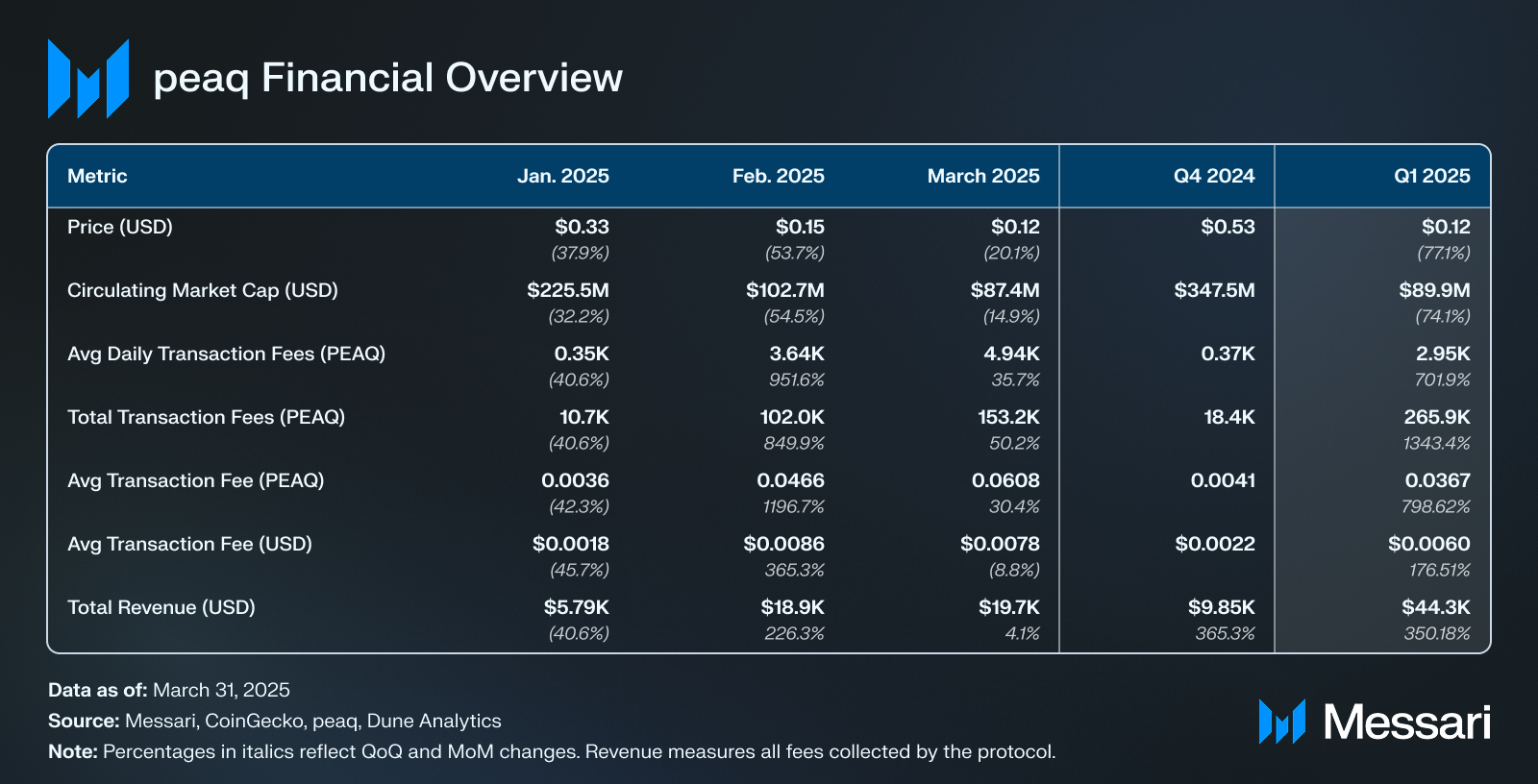
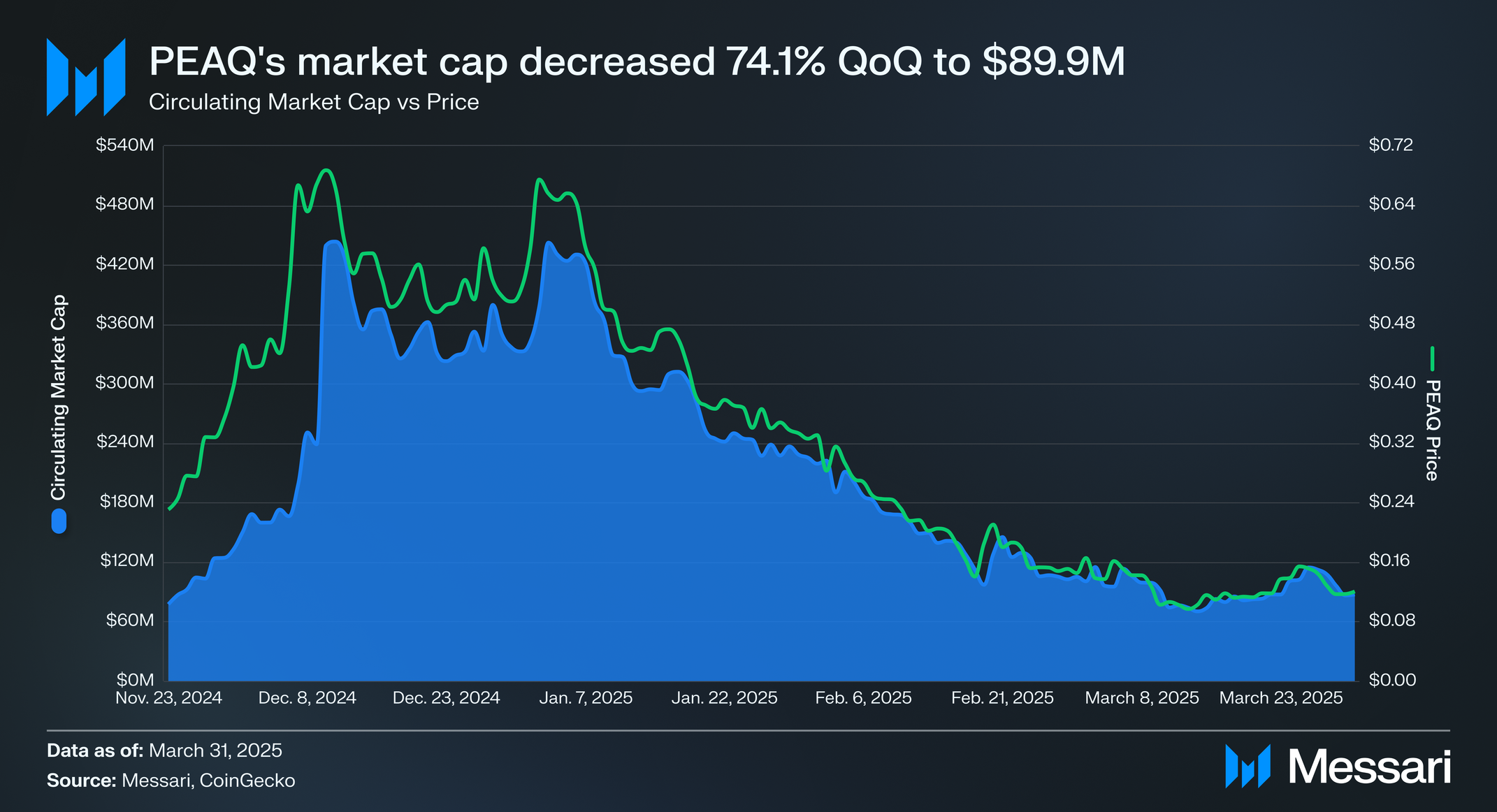
During Q1’25, peaq’s market cap decreased by 74.1% from $347.5 million to $89.8 million while the circulating supply of PEAQ increased by 14.5% QoQ due to community token allocations for the Get Real Campaign Beta and the Early Adopters campaign completing their three-month lockups alongside inflation. Additionally, PEAQ’s price fell 77.0% over the quarter from $0.52 to $0.12. At the end of the quarter, peaq’s market cap ranked 344th among all cryptocurrencies.

During Q1’25, peaq generated $44,334 in total revenue, i.e., all fees collected by the protocol. While still in the early months since its mainnet launch in mid-November 2024, peaq is beginning to establish a measurable baseline for economic activity driven by DePINs. The network is designed for high-throughput and machine-to-machine interactions and employs a micro-fee model with transaction costs as low as $0.00025. These optimizations enable real-world applications to scale without prohibitive costs. peaq’s revenue performance in Q1’25 offers an early indication of the network’s adoption and ability to support machine-enabled value exchange.
Notably, revenue generation increased steadily throughout Q1, rising 146.6% from an average of $288.81 per day in the first half of the quarter to $712.29 in the second. This growth was driven by new DePIN integrations, rising user activity, and incentive programs like the $100 million Get Real Campaign Beta, which rewards users for completing real-world tasks. While modest in absolute terms, the revenue establishes an early benchmark for peaq’s financial scalability as the ecosystem expands.
peaq’s transaction fee model is designed to minimize user costs and support long-term sustainability through strategic revenue allocation. All transaction fees and a portion of newly minted tokens are distributed to network participants who actively engage in the ecosystem and meet specific contribution criteria, such as the value created by machines or liquidity provided to the network. This performance-based approach ensures fairness, drives community participation, and aligns stakeholder incentives. As of Q1’25, the distribution of transaction fees is as follows:
- Validators & Delegators – 40%
- Security Treasury – 10%
- General Treasury – 25%
- DePIN Treasury – 20%
- Machine Subsidization Treasury – 5%
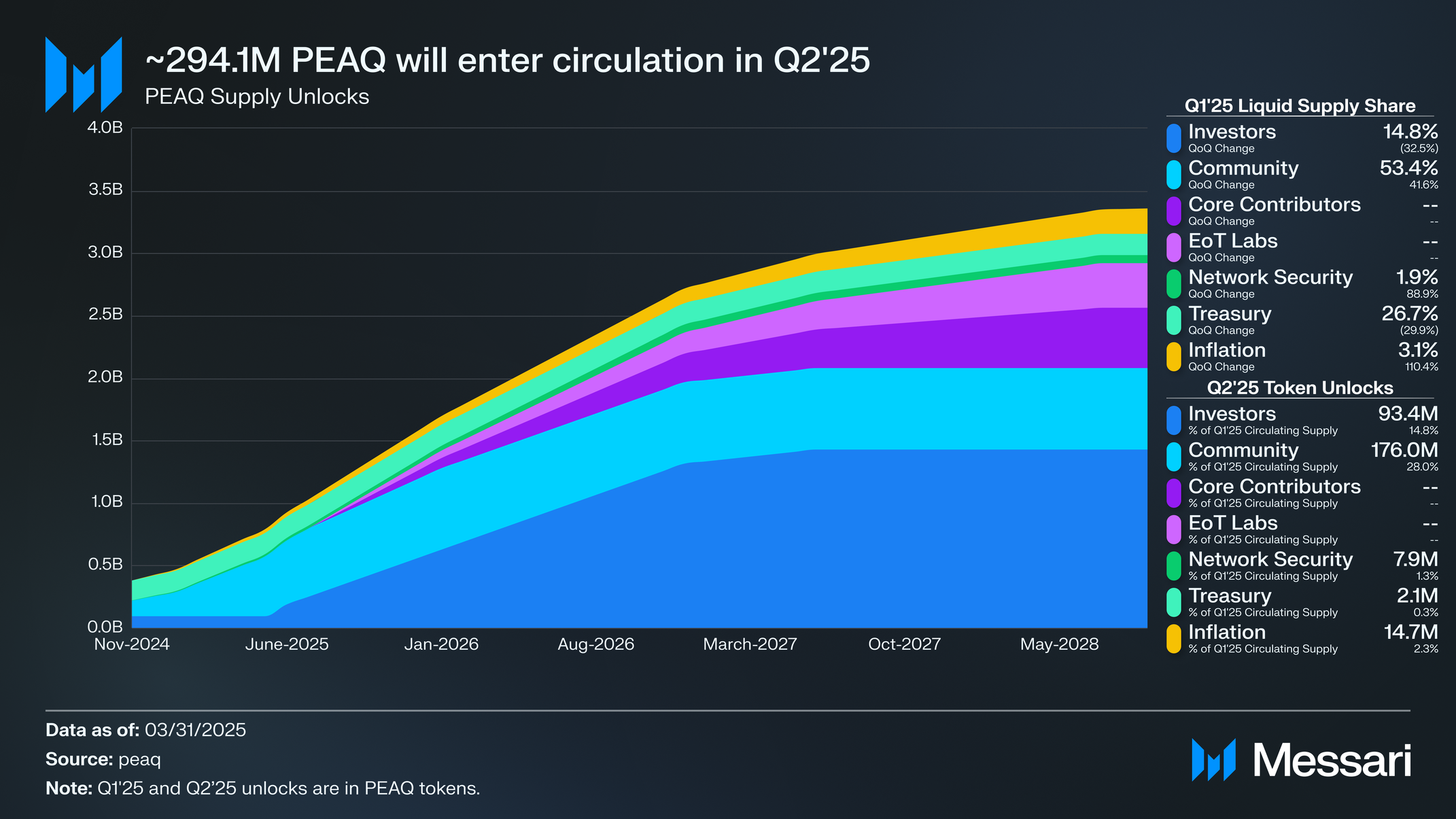
peaq launched in November 2024 with a total genesis token supply of 4.2 billion PEAQ and an initial annual inflation rate of 3.5%. The inflation rate is designed to decrease by 10% each year until it stabilizes at 1%, with future adjustments governed by the network. Of the newly minted tokens, 40% are allocated to staking rewards for delegators and validators, while the remaining 60% is directed to the treasuries described above and remains non-circulating. During Q1’25, 36.75 million PEAQ were minted through inflation. By the end of Q1’25, 14.5% of PEAQ’s genesis supply was liquid, marking a 68.8% QoQ increase. Looking ahead to Q2’25, an additional 279.4 million PEAQ, or 6.7% of PEAQ’s genesis supply, will unlock in addition to inflation.
The key components of the Q2’25 unlocks include:
- Investors (31.8% of Q2 unlocks): 93.45 million PEAQ will unlock to private investors.
- Community (59.8% of Q2 unlocks): 175.98 million PEAQ will unlock to the community.
- Network Security (2.7% of Q2 unlocks): 7.875 million PEAQ tokens will be unlocked for network security.
- Ecosystem/Treasury (0.7% of Q2 unlocks): 2.1 million PEAQ will unlock to the ecosystem.
- Inflation (5.0% of Q1 unlocks): 14.7 million PEAQ are set to be minted from emissions, providing additional liquidity to the market and supporting ongoing network participation incentives.
Network Analysis
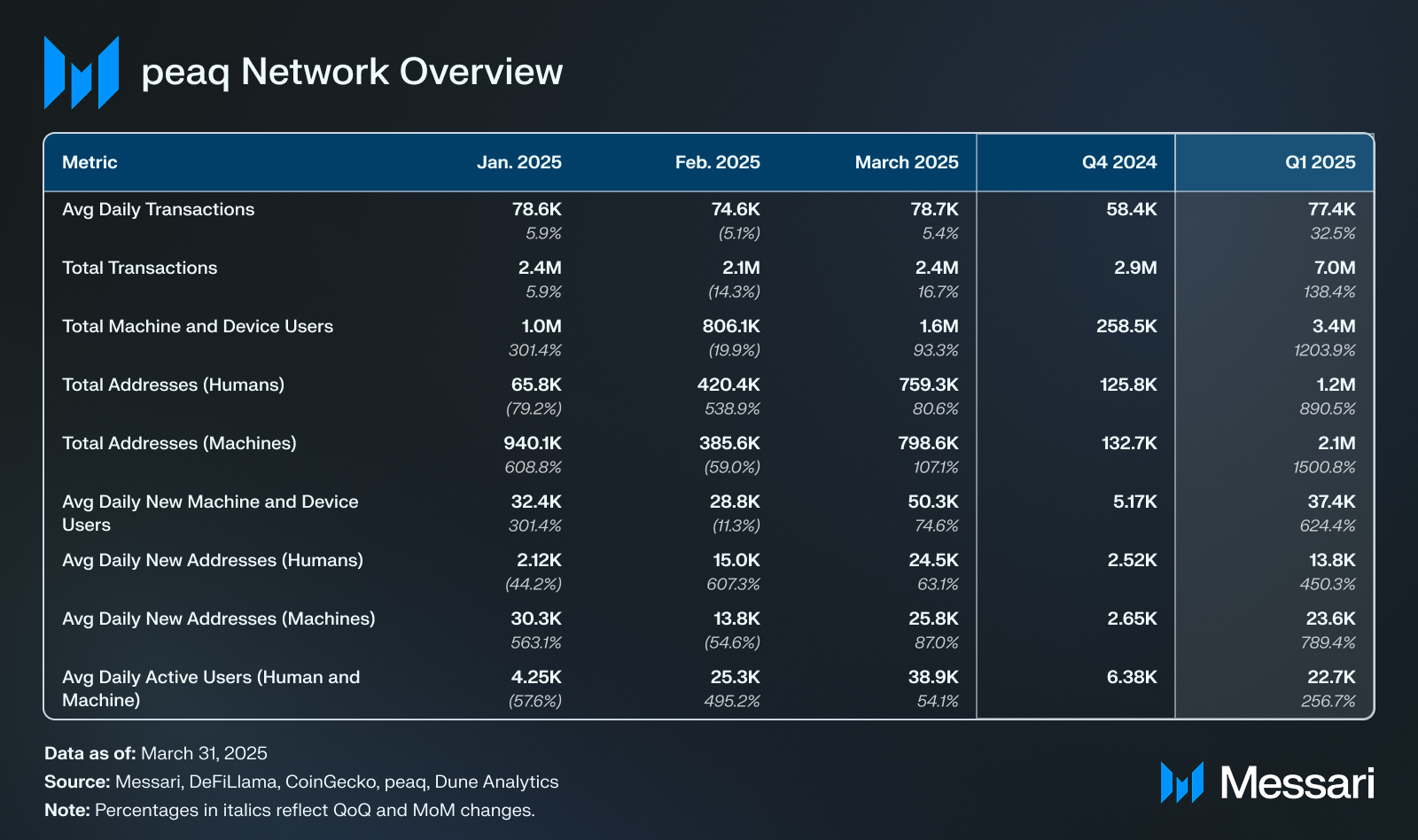
Usage
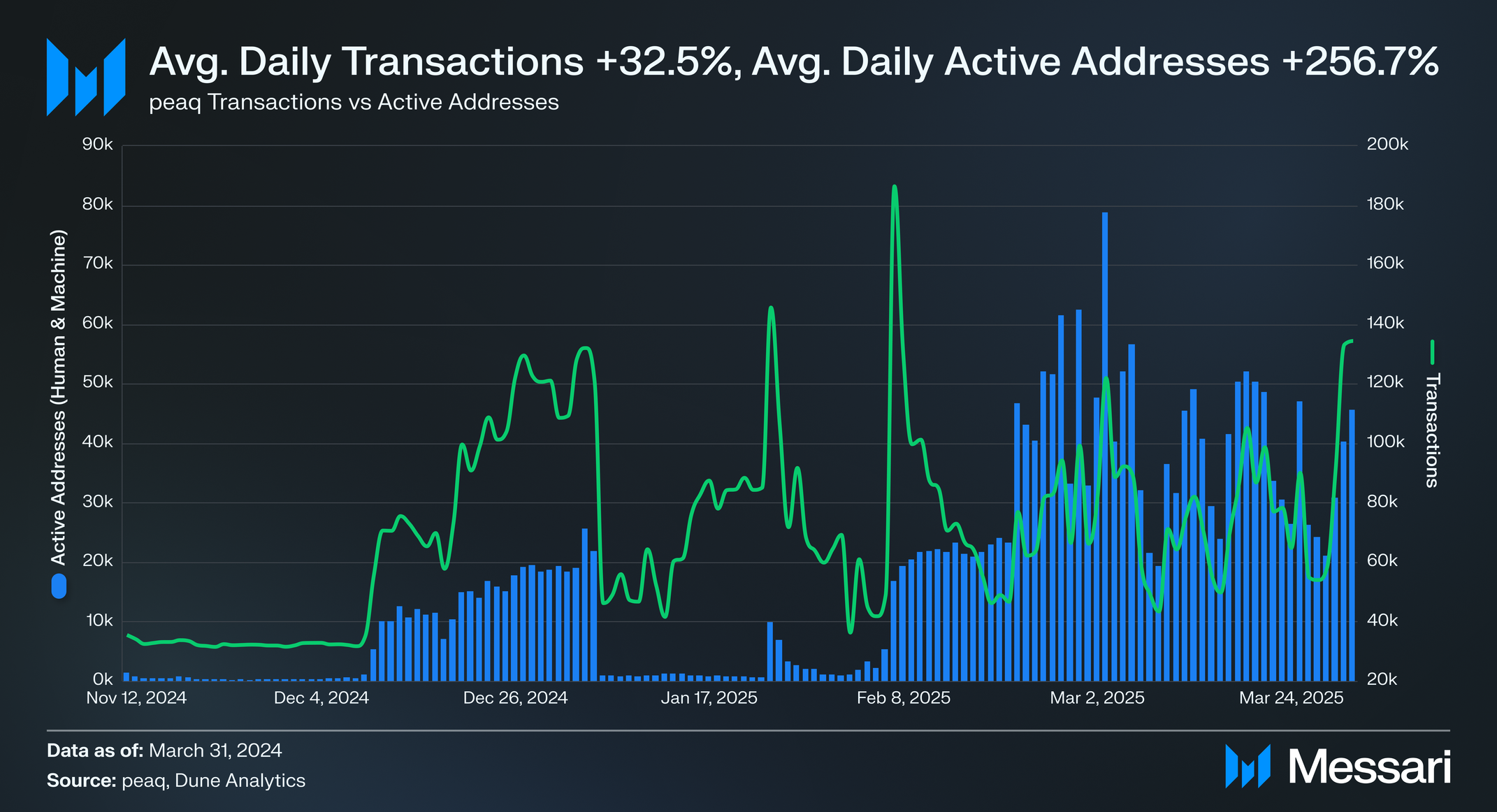
In Q1’25, peaq experienced a 256.7% QoQ increase in average daily active addresses (Human and Machine), which rose from 6,375 in Q4’24 to 22,738 in Q1’25. Average daily transactions on peaq rose 32.5% QoQ from 58,424 in Q4’24 to 77,386 in Q1’25.
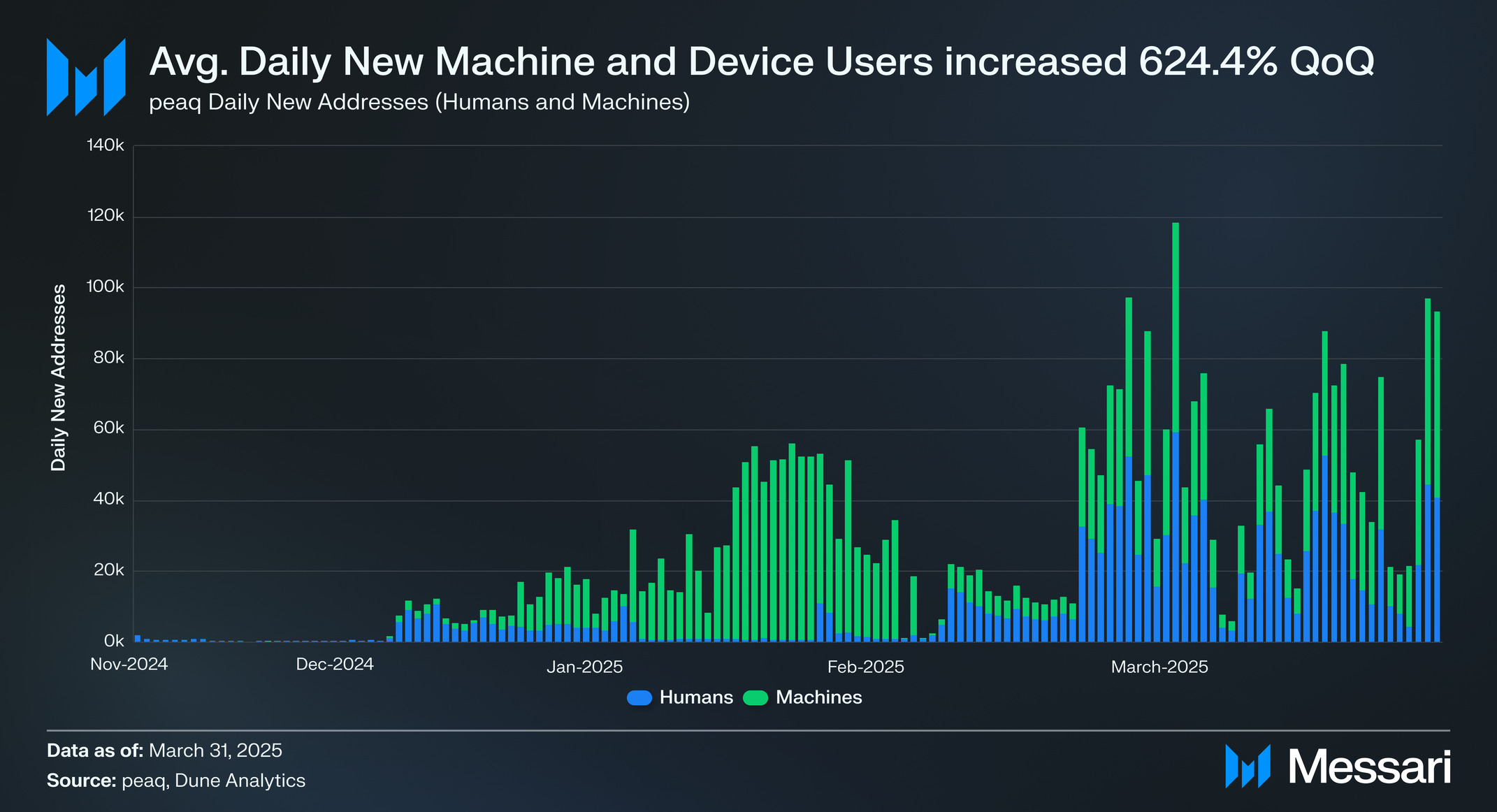
The creation of new addresses, both human and machine-owned, on peaq also increased in Q1’25. Average daily new human addresses increased 450.3% QoQ, and average daily new machine addresses increased 789.4% QoQ from 2,654 in Q4’24 to 23,603 in Q1’25.
The sharp growth in daily active addresses and transactions on peaq in Q1’25 signals the network’s transition from a post-launch phase into early ecosystem expansion. Following its mainnet debut in mid-November 2024, Q1 marked the first full quarter of network activity post-TGE.
A major driver behind the surge in human and machine addresses during Q1’25 was the onboarding of a growing number of DePIN applications. Projects such as Silencio, Teneo, Dats, MapMetrics, SkyX, Kaisar Network launched apps and deployed devices that required identity registration and generated onchain interactions. These machine-native use cases directly contributed to the sharp rise in average daily new machine and human addresses. Growth accelerated further with the February launch of the Get Real Campaign Beta, which incentivized onchain activity across more than 15 DePIN projects through token rewards, gamified quests, and the first wave of token launches and staking incentives.
Security
peaq uses a Nominated Proof-of-Stake (NPoS) consensus model built with Substrate, similar to Polkadot. In this system, validators are selected based on the amount of stake they receive from both self-bonding and delegators. This design helps optimize decentralization while aligning incentives between validators and token holders.
peaq follows a disinflationary token model in which the inflation rate starts at 3.5% annually and decreases by 10% yearly until stabilizing at 1%. Of the newly minted tokens, 40% enter circulation as staking rewards for validators and delegators, while the remaining 60% is directed to non-circulating treasury allocations aimed at long-term ecosystem development.
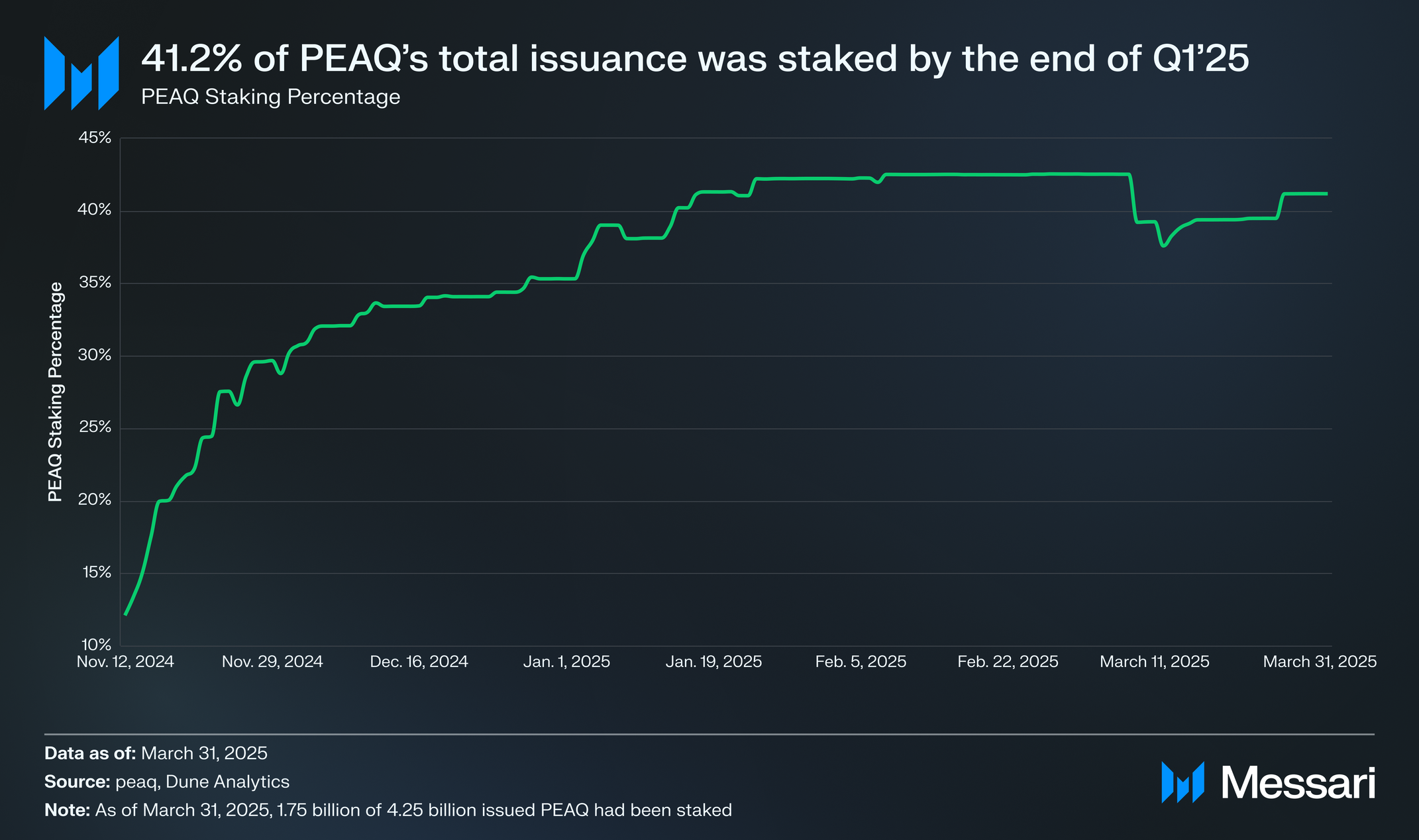
As of March 31, 2025, peaq is secured by 48 active validators, and 1.75 billion staked PEAQ, which accounts for 41.2% of the total PEAQ issuance. On Jan. 2, 2025, peaq increased the active validator cap from 32 to 42 through a runtime upgrade. The same upgrade raised the cap on delegators to 48 per node, introduced flexible validator commission rates, and introduced reward distributions based on network sessions, not every new block. These changes improved staking accessibility, decentralization, and operational efficiency. Validator participation is determined by stake-weighted selection, and rewards are distributed proportionally to both validators and delegators. Throughout Q1’25, the active validator set was expanded to 48 validators.
Validator candidates must meet certain technical and economic requirements to join the active set, including maintaining uptime and infrastructure performance in line with network expectations. peaq uses a stake-weighted selection process, and validators are subject to removal for underperformance. The network is designed to include a slashing mechanism to penalize misbehavior such as downtime or malicious actions, reinforcing honest participation and ensuring protocol integrity. As of May 1, 2025, this feature has not yet been implemented.
Ecosystem Overview
peaq continued building out its Machine Economy network in Q1’25. This effort combines DePINs, DePAI (Decentralized Physical AI), Machine DeFi, and Machine RWAs. These ideas form the foundation for applications where machines and people interact through onchain services tied to real-world value.
By the end of Q1’25, 49 DePINs had joined the peaqosystem, spanning 21 sectors. Three additional DePINs joined peaq during Q1’25:
- AquaSave – a project focused on water conservation that migrated from Solana.
- BigWater – a project that deploys air purifiers and delivers clean water to underserved communities.
- Wagoi – a connected mobility project that puts users in control of their vehicle data.
peaq supports developer adoption through a suite of modular functions available through its SDK. These include machine ID, payment, access control, data verification, and time synchronization tools. With just ~15 lines of code, builders can integrate these into their applications, reducing complexity and accelerating deployment. The following ecosystem map provides a visual overview of the projects integrating peaq’s infrastructure and building on the network.
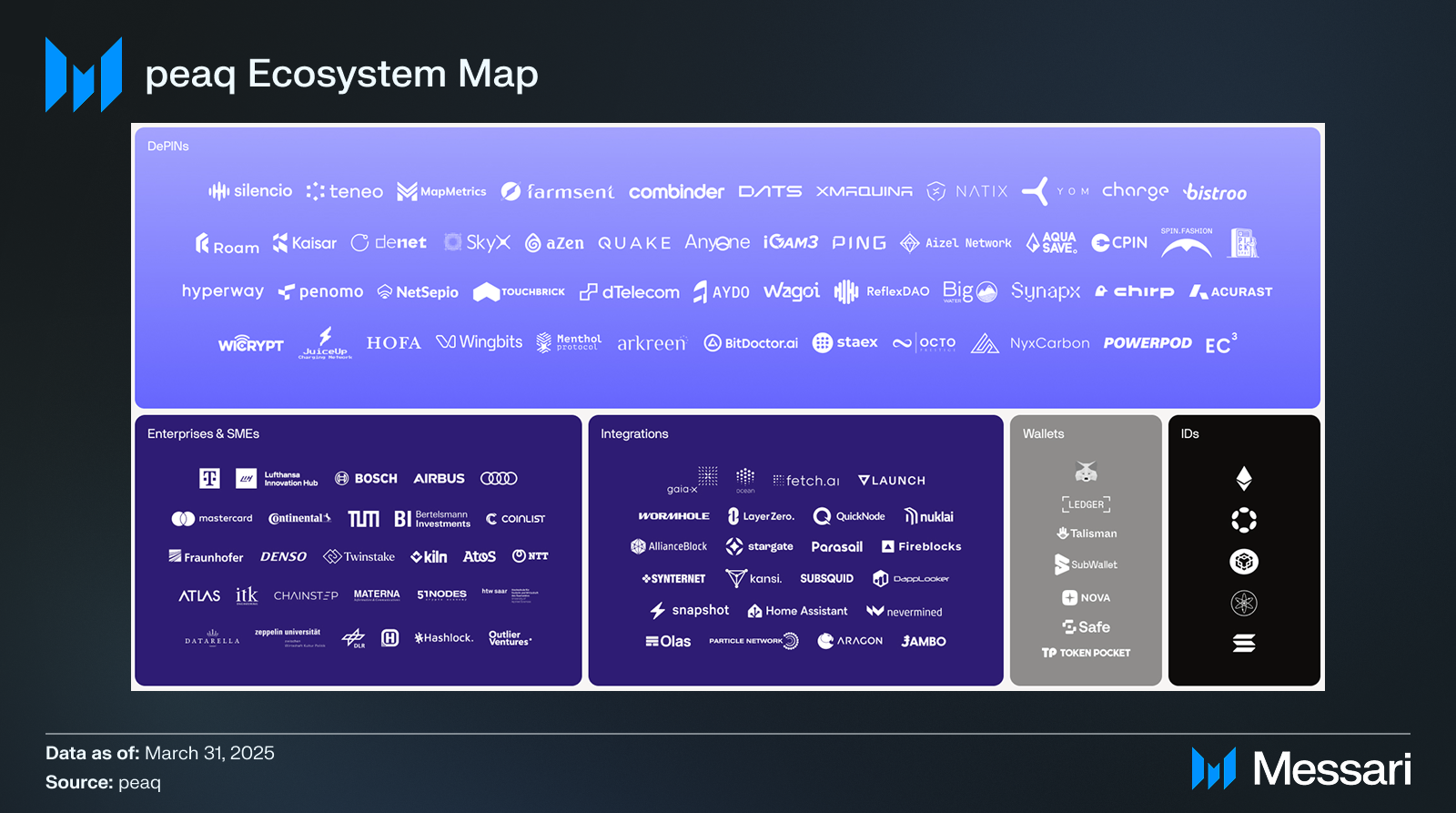
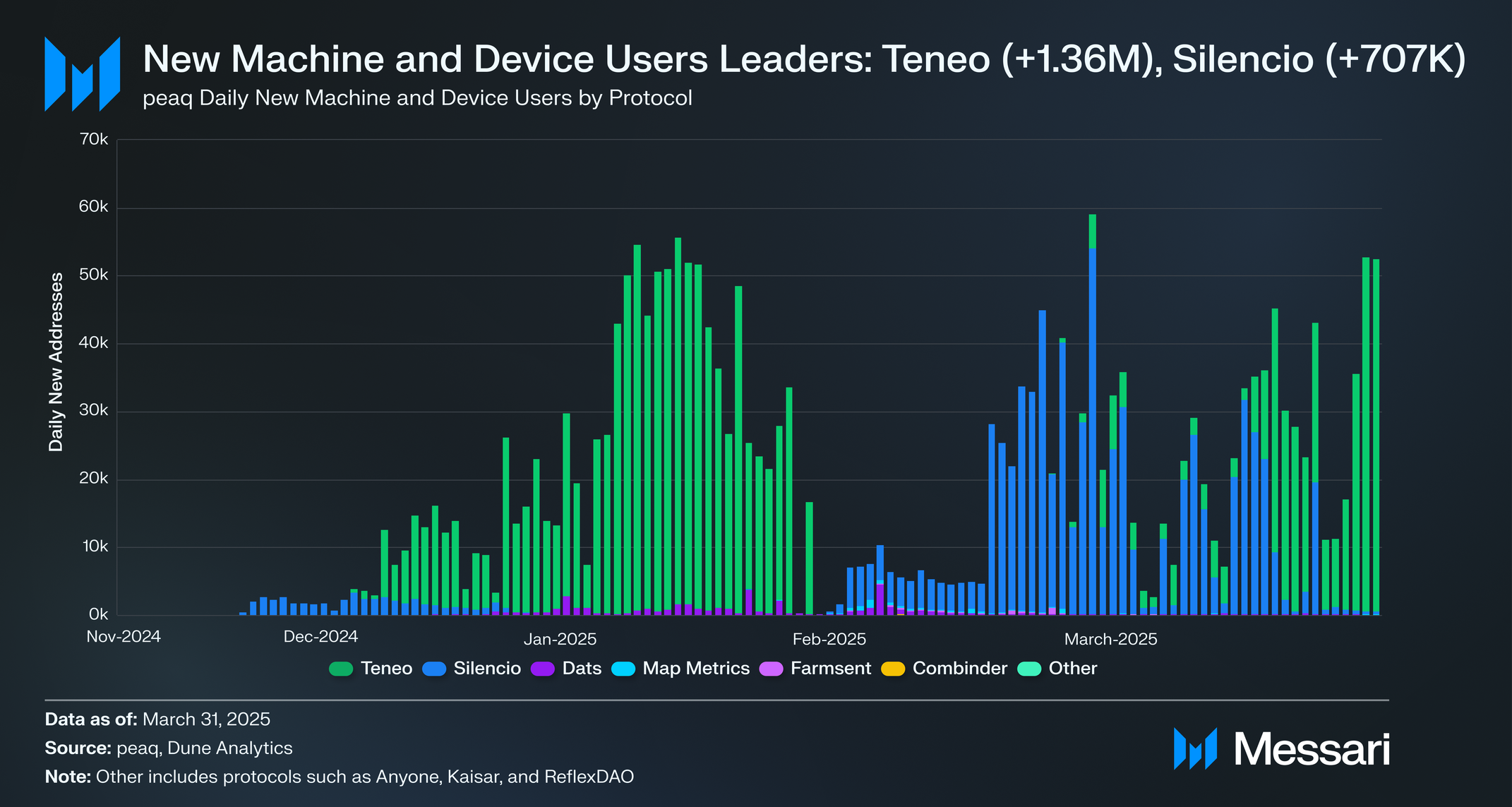
A major driver of peaq’s growth in network activity in Q1’25 was the rapid onboarding of devices and machine identities as the ecosystem began to come online. Teneo, a browser-based DePIN that rewards users for sharing unused social media bandwidth, added 1.36 million new devices. Silencio, a mobile app that measures local noise pollution, contributed 707,000 new addresses, primarily through smartphone-based applications. Additional contributions came from projects such as:
- Dats – a decentralized cybersecurity network.
- MapMetrics – a navigation DePIN, collecting real-time geospatial data.
- Farmsent – a project that connects agricultural producers to blockchain-based supply chains.
- Combinder – a decentralized virtual power plant onboarding distributed energy resources.
In January 2025, PEAQ was listed on both Bithumb and Bitpanda, expanding access and increasing visibility for the network. That same month, Silencio became the first DePIN to launch a token on peaq, rewarding users in SLC for contributing local noise pollution data. That same day, Bistroo migrated 25% of its BIST token supply from Ethereum to peaq, signaling confidence in the network’s ability to support commercial use cases and onchain incentives.
peaqosystem teams also raised over $4 million during the quarter to fund development, scale infrastructure, and grow user adoption. These developments show peaq progressing beyond its initial launch phase and beginning to establish early onchain economic activity. Projects are beginning to activate token economies and link real-world machine output with programmable financial tools. Further developments in Q1’25 include integrations with Token Terminal and QuickNode, expanded analytics capabilities, and improved developer access.
Machine DeFi and RWAs
peaq’s financial architecture is built to accommodate machines as direct participants in economic systems. In Q1, peaq laid the initial groundwork for Machine DeFi and Machine RWAs, establishing technical capabilities to support financial interactions linked to machine-generated value.
Machine DeFi refers to the emerging category of decentralized finance in which machines could eventually transact autonomously with protocols, using onchain data derived from their activity. Envisioned use cases include borrowing against tokenized machine revenue, automated fee flows between machine agents, and DAO-managed subsidy programs. While these remain aspirational today, peaq’s infrastructure upgrades and modular functions are designed to support such interactions as they mature.
A foundational component of this vision is Machine RWAs. These are machines, or rights to their services and output, represented as onchain assets. This model enables token holders to earn from machine performance and allows devices to interact with DeFi protocols using verifiable, real-world metrics. Although no Machine RWAs are actively deployed on peaq as of this report, the groundwork for tokenization, identity, and payment processing is now in place.
A key enabler of these future applications arrived in Q1’25 with the launch of USDT on peaq via Stargate’s Hydra integration. USDT provides a stable medium of exchange for DePINs and future Machine DeFi protocols. By pricing services and executing transactions at stable value, machines and their users gain predictability, which is critical for financial coordination and adoption.
Though Machine DeFi on peaq remains in the infrastructure and design phase, the pieces are beginning to align. As DePINs generate revenue, stakeable assets, and machine-level data, new models for value capture and financial coordination may follow. The next phase will depend on real deployments that use this architecture to build tokenized machine services and economic relationships at scale. Looking ahead, the rollout of Machine DeFi suites v1 and v2 is a major focus of peaq’s roadmap in Q2 and Q3 2025, with the planned launch of the world’s first Machine Economy DEX, a native DePIN launchpad, a framework for Machine RWAs, a native stablecoin, and machine-native money markets. These developments are intended to transform peaq’s early groundwork into a fully operational financial layer for the Machine Economy.
Decentralized Physical AI (DePAI)
While Machine DeFi and Machine RWAs introduce financial tools and ownership models for machines, the next step is equipping those machines with the intelligence to operate independently. As autonomous systems take on more responsibility across sectors, their ability to interact, make decisions, and transact onchain becomes essential. This shift is now taking shape with the emergence of decentralized physical AI (DePAI), a model that integrates robotics, agentic AI, and Web3 infrastructure into a new layer of the Machine Economy.
DePAI is composed of seven foundational layers:
- Hardware – robots that allow AI models to interact with the physical world.
- Software – agentic AI models running on those robots.
- Data – allows the physical AI to learn and evolve.
- Spatial Intelligence – Enables robots to comprehend and interact with the physical world.
- Infrastructure Networks – provide the key requirements like storage, compute, energy, and more.
- A Machine Economy – This layer brings together all dedicated protocols that ensure interoperability and precise coordination between DePINs, AI models, and robots.
- DAOs – Allow individuals, communities, and businesses to own and earn from the DePAIs.
On peaq, projects such as Silencio, SkyX, and Teneo contribute critical sensor data, while tools like Universal Machine Time (UMT) provide precise synchronization. Governance and capital formation are addressed through the XMAQUINA DAO, a decentralized organization focused on funding and overseeing the development of robotics and Physical AI. Built on peaq, XMAQUINA utilizes network-wide integrations with Aragon OSx, Snapshot, and smart contracts to create a transparent governance system for coordinating machine infrastructure. This model allows communities to co-own, co-govern, and benefit from DePAI applications built on peaq.
These components form the foundation for machines to operate autonomously, generate value, and coordinate with other agents onchain. While DePAI is still in its early stages, peaq has begun assembling the infrastructure needed to support it, from machine identity and time synchronization to data feeds and decentralized governance. DePAI is positioned to become a core layer of the Machine Economy as these systems evolve, enabling intelligent machines to interact directly with decentralized applications and financial protocols.
Ecosystem Growth
In Q1’25, peaq continued to attract new DePINs that expanded the scope and diversity of its ecosystem. These projects use peaq’s infrastructure to onboard devices, structure incentives, and link machine activity to onchain value. From clean water and air to connected mobility, this quarter’s additions illustrate how peaq is becoming a foundation for real-world applications across multiple sectors.
AquaSave
AquaSave migrated from Solana and joined the peaq ecosystem in Q1 as a DePIN project focused on water sustainability. The project deploys smart devices, called AquaBanks, that capture and reuse warm water from household appliances, reducing water and energy waste. Users earn rewards for sharing conservation data through these devices, helping bridge Web3 incentives with real-world impact.
AquaSave secured a partnership with the Balearic government for regional deployment and is supported by Wilo, a global pump manufacturer, for international distribution. The project will launch its native token on peaq, implement peaq IDs for device identity, and use peaq’s infrastructure to power its onchain reward and data-sharing mechanisms.
BigWater
BigWater joined the peaq ecosystem in Q1 as a DePIN project addressing air pollution and clean water access. The project deploys air purifiers that filter pollutants and trigger water distribution efforts. For every BigWater device brought online, the project delivers 1,000 liters of clean water to underserved communities. These actions are tracked and verified onchain, pairing real-world environmental impact with blockchain-based incentives.
BigWater uses peaq IDs to authenticate air purifiers and water sensors, and relies on peaq’s modular DePIN functions to manage machine identity, data integrity, and token rewards. peaq’s low-cost transactions help streamline machine-to-network interactions while data hashing ensures transparency in recorded outcomes. BigWater also partnered with JanaJal, which provides safe drinking water to hundreds of thousands of people in Asia through decentralized infrastructure.
BigWater will launch its token, BWT, on peaq and integrate into its network of DePIN applications. Its approach blends environmental sustainability with Web3 participation by rewarding users for deploying real-world infrastructure that directly improves air and clean water accessibility.
WAGOI
WAGOI also joined the peaq ecosystem in Q1 with a mission to return control of vehicle-generated data to drivers. As a mobility-focused DePIN, WAGOI lets users connect their vehicles and decide if and how their driving data is shared with third parties, such as insurance companies or automotive service providers. In return, drivers can earn rewards without installing any dedicated hardware. Instead of car manufacturers monetizing this data, WAGOI shifts the value proposition back to the individual, turning everyday driving into a source of perks and benefits.
On peaq, WAGOI assigns connected vehicles unique machine identities using peaq IDs, enabling users to collect and control their driving data, which can be exchanged for tokens on WAGOI’s data marketplace. The project’s reward system is implemented through smart contracts and leverages peaq’s low-cost microtransactions to handle frequent, machine-triggered value exchanges. As a corporate partner of Fisita and a member of INATBA, WAGOI brings industry credibility to a user-first vision of data sovereignty in mobility. With the EU Data Act taking effect in late 2025, WAGOI is positioned to help usher in a new era of driver-controlled data across the automotive sector.
Ecosystem Funding
In Q1’25, multiple peaq-native projects secured external funding, demonstrating growing investor confidence in the Machine Economy. These fundraising rounds are helping DePINs scale real-world infrastructure, launch tokens, and expand user acquisition efforts. Early financial backing also signals that projects building on peaq are attracting both institutional and grassroots interest as they prepare for long-term deployment.
XMAQUINA
In Q1’25, XMAQUINA DAO launched and sold out the first wave of its DEUS Genesis Auction, raising $900,000 from 1,045 contributors. The auction marked a milestone in decentralizing robotics and physical AI by shifting capital formation from venture capital to community ownership. Notable participants included institutional backers such as MH Ventures, Signal Ventures, and Mulana Capital, alongside angel investors like Delphi Digital co-founder Anil Lulla. XMAQUINA launched wave 1.5 of its auction on April 29, 2025.
Teneo Protocol
Teneo, a DePIN focused on unlocking public social media data via browser nodes, raised $3 million in a seed round led by RockawayX and Borderless Capital, with participation from Generative Ventures, Certik Ventures, and others. With over 3.9 million users, the project is scaling its data infrastructure and preparing for its token generation event. Teneo will use peaq for its data verification, identity, and reward logic.
Combinder
Combinder, a decentralized energy DePIN, secured $500,000 in pre-seed funding at a $10 million valuation. The round was led by Outlier Ventures, 1kx, Moonrock Capital, and MN Capital. The funding will support the expansion of Combinder’s global virtual power plant and the development of its SDK and energy APIs. Combinder rewards users who connect distributed energy resources and share usage data. The project is building its infrastructure on peaq.
Roadmap
peaq’s roadmap for Q2 and Q3 2025 focuses on scaling the network’s infrastructure, expanding Machine DeFi, and deepening developer and user engagement. These milestones are designed to transition the Machine Economy from early activation into broader adoption and technical maturity.
Q2 2025
- Machine DeFi Suite v1
- Launch of the world’s first Machine Economy DEX
- Launch of the peaq-native DePIN Launchpad
- Integrations with bridges, aggregators, wallets, and other infrastructure
- Get Real Campaign
- Official launch of the network-wide incentivization campaign
- Build
- Achieve 65,000 TPS and <0.4s block times on testnet
- SDK upgrades for JavaScript and Python
- New Exchange listing(s)
Q3 2025
- Machine DeFi Suite v2
- Introduction of Machine RWAs
- Launch of the peaq-native Stablecoin
- Development of Machine-native money markets
- Build
- Achieve 65,000 TPS and <0.4s block times on mainnet
- Chain fee market upgrade
- Major developer experience improvements
- Publication of the “Purple Paper”
Closing Summary
During Q1’25, peaq market cap declined 74.1% from $347.5 million to $89.8 million, as PEAQ’s token price fell 77.0% and circulating supply increased 14.5% QoQ. Despite market headwinds, network usage increased across key metrics. Average daily active addresses rose 256.7% to 22,738 and average daily transactions climbed 32.5% to 77,386. Average Daily new machine addresses surged 789.4% to 23,603, led by deployments from Teneo and Silencio.
Q1’25 marked the first full quarter of activity following peaq’s mainnet launch, with early signs of onchain engagement taking shape. Silencio launched the first DePIN-native token, SLC, and Bistroo migrated a portion of its token supply to peaq. The introduction of USDT via Stargate’s Hydra integration provided a stable medium of exchange, supporting early Machine DeFi infrastructure. Meanwhile, DePAI gained momentum through data contributions from machine-native protocols and the launch of XMAQUINA DAO.
peaq’s modular SDK, staking upgrades, and developer integrations with QuickNode and Token Terminal improved access and observability for builders. Over $4 million in ecosystem funding was raised across three DePINs, and the network continued expanding into new verticals, including water sustainability, energy, and mobility. With over 49 DePINs now building on peaq across 21 sectors, peaq enters Q2’25 with foundational infrastructure in place to support autonomous machines, economic coordination, and community-owned physical infrastructure at scale.
Let us know what you loved about the report, what may be missing, or share any other feedback by filling out this short form. All responses are subject to our Privacy Policy and Terms of Service.
This report was commissioned by peaq Network. All content was produced independently by the author(s) and does not necessarily reflect the opinions of Messari, Inc. or the organization that requested the report. The commissioning organization may have input on the content of the report, but Messari maintains editorial control over the final report to retain data accuracy and objectivity. Author(s) may hold cryptocurrencies named in this report. This report is meant for informational purposes only. It is not meant to serve as investment advice. You should conduct your own research and consult an independent financial, tax, or legal advisor before making any investment decisions. Past performance of any asset is not indicative of future results. Please see our Terms of Service for more information.
No part of this report may be (a) copied, photocopied, duplicated in any form by any means or (b) redistributed without the prior written consent of Messari®.
